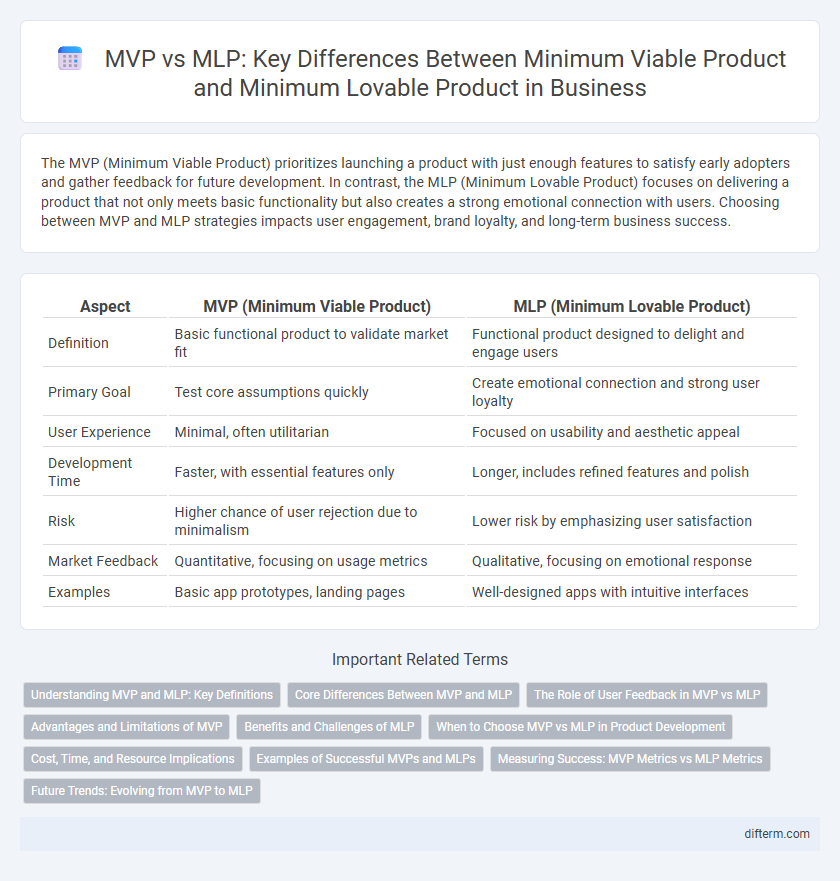The MVP (Minimum Viable Product) prioritizes launching a product with just enough features to satisfy early adopters and gather feedback for future development. In contrast, the MLP (Minimum Lovable Product) focuses on delivering a product that not only meets basic functionality but also creates a strong emotional connection with users. Choosing between MVP and MLP strategies impacts user engagement, brand loyalty, and long-term business success.
Table of Comparison
| Aspect | MVP (Minimum Viable Product) | MLP (Minimum Lovable Product) |
|---|---|---|
| Definition | Basic functional product to validate market fit | Functional product designed to delight and engage users |
| Primary Goal | Test core assumptions quickly | Create emotional connection and strong user loyalty |
| User Experience | Minimal, often utilitarian | Focused on usability and aesthetic appeal |
| Development Time | Faster, with essential features only | Longer, includes refined features and polish |
| Risk | Higher chance of user rejection due to minimalism | Lower risk by emphasizing user satisfaction |
| Market Feedback | Quantitative, focusing on usage metrics | Qualitative, focusing on emotional response |
| Examples | Basic app prototypes, landing pages | Well-designed apps with intuitive interfaces |
Understanding MVP and MLP: Key Definitions
Minimum Viable Product (MVP) refers to the most basic version of a product designed to validate core functionalities and gather user feedback with minimal resources. Minimum Lovable Product (MLP) expands on MVP by emphasizing user experience and emotional connection, aiming to create a product that users not only use but genuinely enjoy. Understanding these distinctions helps businesses prioritize product features and allocate resources effectively during early development stages.
Core Differences Between MVP and MLP
The core difference between an MVP (Minimum Viable Product) and an MLP (Minimum Lovable Product) lies in their focus: MVP emphasizes basic functionality to test market viability with minimal resources, while MLP prioritizes creating an emotionally engaging user experience that encourages retention. MVP aims to validate hypotheses quickly to reduce time to market, whereas MLP strives to build a strong user connection and brand loyalty from the start. Businesses leveraging MLP tend to invest more in design and user-centric features compared to the lean and functional approach of MVP.
The Role of User Feedback in MVP vs MLP
User feedback drives the iterative development process in both MVP and MLP, but with distinct emphases; MVP relies on essential user input to validate core functionalities and market fit, while MLP prioritizes feedback that enhances emotional engagement and product delight. In MVP, feedback centers on usability and functionality gaps to ensure basic value delivery, whereas MLP feedback targets feature refinement that creates memorable user experiences and fosters loyalty. Understanding the nuanced differences in user feedback helps businesses optimize product development strategies for either rapid market entry or deeper user connection.
Advantages and Limitations of MVP
MVP (Minimum Viable Product) accelerates market entry by delivering core functionalities with minimal resources, enabling rapid user feedback and iterative improvements. Its primary advantage lies in validating business hypotheses quickly, reducing development costs and time-to-market risks. However, MVPs often lack emotional engagement and polish, which can limit customer appeal and hinder building strong brand loyalty compared to MLP (Minimum Lovable Product) approaches.
Benefits and Challenges of MLP
Minimum Lovable Product (MLP) enhances user engagement by focusing on delivering a product that not only meets basic functionality but also delights customers with exceptional design and experience. Benefits include higher customer retention and stronger brand loyalty as users develop a genuine attachment to the product, driving organic growth. Challenges involve increased development time and costs, requiring careful resource allocation to balance essential features with elements that evoke emotional connections.
When to Choose MVP vs MLP in Product Development
Choose an MVP (Minimum Viable Product) when rapidly validating core assumptions and gathering user feedback with minimal resources is essential in early-stage product development. Opt for an MLP (Minimum Lovable Product) when market differentiation and strong user engagement are critical to gaining customer loyalty and competitive advantage. Prioritizing MVP suits startups needing quick iteration, while MLP aligns with established companies focusing on user experience and long-term retention.
Cost, Time, and Resource Implications
MVP (Minimum Viable Product) emphasizes launching a product with core features to minimize development time and cost, requiring fewer resources and enabling quick market validation. In contrast, MLP (Minimum Lovable Product) demands additional investment in design and user experience to foster customer affinity, which increases time and resource allocation but can lead to higher retention and brand loyalty. Businesses must balance MVP's efficiency against MLP's potential for sustained engagement when allocating budgets and timelines.
Examples of Successful MVPs and MLPs
Successful MVPs like Dropbox initially offered basic file synchronization features, validating core functionality with minimal resources. MLPs, exemplified by Airbnb, focused on an engaging user experience early on, combining essential features with design elements that fostered strong customer loyalty. These approaches demonstrate how MVPs prioritize feasibility testing, while MLPs emphasize emotional connection to accelerate market adoption.
Measuring Success: MVP Metrics vs MLP Metrics
MVP metrics primarily focus on validating core functionality through user engagement, retention rates, and activation metrics to ensure the product solves the fundamental problem efficiently. MLP metrics emphasize emotional connection, customer satisfaction scores, Net Promoter Score (NPS), and brand affinity to gauge how well the product delights and retains users long-term. Measuring success in MVP centers on product-market fit, while MLP metrics target sustained user love and advocacy for scalable growth.
Future Trends: Evolving from MVP to MLP
Future trends in product development emphasize shifting from MVP (Minimum Viable Product) to MLP (Minimum Lovable Product), prioritizing customer experience and emotional connection over basic functionality. Companies integrating user feedback and leveraging AI-driven analytics achieve higher user retention and brand loyalty by delivering products that resonate deeply with target audiences. This evolution supports sustainable growth and differentiates offerings in competitive markets through enhanced usability and customer-centric design.
MVP (Minimum Viable Product) vs MLP (Minimum Lovable Product) Infographic

 difterm.com
difterm.com